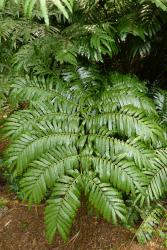Terrestrial ferns. Rhizomes short, erect. Fronds monomorphic. Stipes bearing non-clathrate, fimbriate scales. Laminae 2–4-pinnate, catadromous, bearing hairs and scales. Terminal segments on primary pinnae usually with a prominent suture at the point of attachment; margins of ultimate segments usually toothed. Pulvini absent from stipes, present at the base of pinnae and, obscurely, the ultimate segments. Veins free and undivided or 1-forked; false veins absent between true veins. Sori superficial, marginal to medial, surrounded by nest-like rings of paraphyses, composed of two opposing rows of sporangia either side of vein, each fully fused into a synangium. Synangia sessile, not sulcate along the septa between the sporangia when mature, deeply cut when open with no central pad of tissue. Sporangia each dehiscing via a vertical slit, the apertures lacking labia or slightly labiate. Spores monolete, bilaterally symmetrical, granulate or verrucate.
A genus of about 20 species. Murdock (2008) split Marattia sens. lat. into three monophyletic genera: Eupodium, Marattia sens. str. and Ptisana. The first two genera are confined to the Neotropics and Hawai’i whereas Ptisana occurs widely in the Old World. Eupodium is morphologically distinguished by its prominently stalked synangia, presence of awns along the veins on the adaxial surface of the pinnae, and its habit of producing only one or two fronds at a time. Ptisana is characterised by having the terminal segment on each primary pinna with a distinct suture at the point of attachment, lack of false veins, synangia that are not sulcate along the septa between the sporangia, and sporangial apertures that are not or only slightly labiate. Marattia lacks a suture on the terminal pinna, sometimes has false veins and has sulcate synangia and labiate sporangial apertures.
About 20 species widely distributed in the Palaeotropics, with one on Ascension Island, one in southern Africa and the Indian Ocean, 12 in Malesia extending north to Vietnam, and six in the Pacific from eastern Australia to Micronesia and the Marquesas Islands.
| Category | Number |
|---|---|
| Indigenous (Non-endemic) | 1 |
| Total | 1 |
n = 39, 78 (Murdock 2008). A base number of x = 40 is recorded for Danaea, Christensenia, Marattia and Angiopteris (Camus 1990). No chromosome number has been reported for Eupodium, and further investigation is required to determine whether x = 39 is a synapomorphy for Ptisana.




